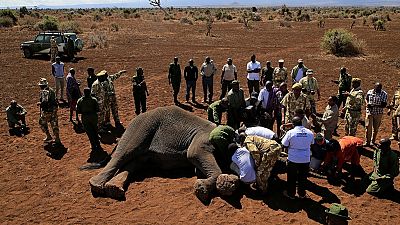Kenya
Elephants in Kenya are getting fitted with radio collars to help secure the corridors they use between national parks.
The collars transmit a satellite and radio signal using GPS technology to map out the elephants’ migratory routes and identify how far they travel in search of water and vegetation.
Securing the corridors is one way to end human wildlife conflicts.
“The biggest challenge I have in terms of conservation in the country, is finding space for wildlife. Our population is increasing and also our conservation efforts have been successful such that elephant populations have stabilized and even increasing. The reason we are doing the collaring today is so that we understand the migratory routes of the elephants. Once we know the migratory routes of the elephants, then we can plan our land use”, said Kenya’s Minister of Environment, Judi Wakhungu.
Azzedine Downes, President of the International Fund for Animal Welfare added, “This is land that is owned by the community, so it is very important to understand that the elephants spend most of their time in fact outside of the national park. And it is really important that we know where they go, how they interact with other animals, and how they interact with the community, so that we can sort of track where they go and if there are instances of human wildlife conflict we are able to figure out why that happens and to try to prevent it.”
Conservationists use a combination of helicopters, vehicles and elders from the local Masaai tribe to track the elephants across the savannah.
More than 1,400 elephants live in the Amboseli ecosystem, spending 80 per cent of their time outside Amboseli National Park.
14 elephants are currently being tracked under the program.
“The Amboseli ecosystem is increasingly under pressure from human development and yet the Amboseli ecosystem is one of our most important because of the connection to Tanzania and beyond. We have studied these elephants for over 40 years, we understand them and we know them. But we also know that in terms of conservation, water catchment, critical areas connecting to Kilimanjaro and also further on to Mara, we must conserve this ecosystem. When we understand what is happening in Amboseli, we can then translate this into other parts of the country”, Judi Wakhungu said.
The collars provide rangers an early warning if the elephants are straying too close to human habitation.
Tracking data from the project showed elephants could be deterred by electric fences around farms.
The Kenya Wildlife Service says elephant numbers had increased to 32,000 from a low of 16,000 in 1989, the year that the world conservation body banned sales of ivory from African elephants.
But elephants remain threatened by poaching and loss of habitat.
Agencies













01:02
Pics of the day: April 18, 2024
01:00
Pics of the day: April 17, 2024
02:08
Devastating floods ravage parts of east Africa, displacing thousands
01:35
Kenya: Doctors begin fifth week of strike
Go to video
Beijing half marathon hit by controversy as China’s He Jie allowed to win
01:13
Kenya power delivers cheaper electricity bills for residents